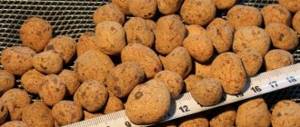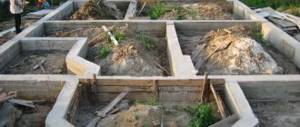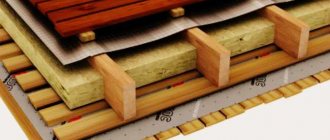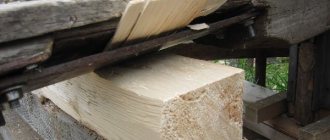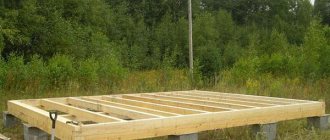Concrete structures, despite their external indestructibility, lose their strength when exposed to water. Many pores and cracks in the concrete structure very quickly absorb water from the ground or during rain. Penetrating into the deep layers of building materials, moisture can seep through the walls, causing the development of fungus and destruction of the finish. Only reliable protection of concrete walls and foundations from water can save the situation. Penetron, a penetrating waterproofing agent, helps reduce the hygroscopicity of concrete. A feature of the penetrating composition is its ability to change the internal structure of concrete.
Penetrating waterproofing Penetron is a deep waterproofing with a complex chemical process occurring inside the concrete. The product contains chemicals that are activated in the aquatic environment. Penetrating into the thickness, they react with aluminum and calcium in the cement and create crystalline formations that clog cracks and pores. When the treated surface is re-wetted, the chemical process is activated again, forming new crystals and compacting the structure. Even water pressure on the treated surface cannot overcome the created protective barrier.
History of the origin of the material
A set of waterproofing materials under the general name “Penetron” was developed in the USA more than half a century ago, which then became a transnational company. In Russia, Penetron waterproofing began to be produced under license in 1991, when the Penetron-Russia enterprise was formed, which was later transformed into a large holding company. The plant producing dry mixtures was built in Yekaterinburg and operates under the control of the international corporation ICS Penetron International Ltd. All work of the management of the Penetron-Russia holding is certified according to quality standards adopted in the European Union, and products are certified according to the European CE system.
European conformity[Conformité Européenne]
The abbreviation CE stands for Conformité Européenne (French) - European conformity, and means that products or materials meet special quality requirements established by the European Union. The mark is applied to the product or packaging.
The use of the Penetron system has the following advantages:
- The water resistance class of structures after treatment with a complex of materials increases by 3-4 levels;
- the durability of waterproofing is equal to the durability of the structure;
- pressure structures are treated from the inside or outside as necessary, since the direction of hydrostatic pressure does not matter;
- to work with the Penetron complex you do not need any special preparatory operations, pre-drying or other complex actions, you only need to moisten the surface;
- concrete protected by Penetron changes its physical properties for the better - all quality indicators increase;
- the technology of work is simple, it does not require any complex equipment;
- the materials are non-flammable, certified according to sanitary standards and can be used for drinking water tanks;
- relatively low cost.
Operating principle of penetrating waterproofing
The liquid insulation solution is applied only to the wet concrete surface. By interacting with the base material, the mixture creates a high chemical potential while maintaining a lower potential of the internal structure of concrete. The resulting osmotic pressure promotes the penetration of Penetron deep into the material of the insulated structure.
The higher its humidity, the faster and more efficiently this process will occur. Waterproofing components are capable of penetrating several tens of centimeters into concrete structures.
"Penetron"
Penetrating waterproofing "Penetron" is produced in accordance with the technical document - TU 5745-001-77921756-2006. The dry mixture includes Portland cement M500, fine sand, and chemical additives. The exact composition is the intellectual property of the company and is for internal use only.
Treatment with Penetron prevents moisture from seeping through any concrete structures, and the amount of water pressure does not matter. The material protects concrete structures from chemical aggression from acids and alkalis, contaminated groundwater, and salt water in structures exposed to the sea.
Effect of Penetron products
Before use, the dry mixture is diluted with water (the exact ratios are given below), and the resulting plastic solution is coated with the pre-moistened protected surface of the concrete structure. The principle of operation of the material in the design is based on four physical and chemical laws:
- osmosis and the resulting diffusion;
- particle movements according to Brown's law;
- reactions during solidification;
- surface tension of liquids.
After processing, a difference in chemical potentials, that is, a difference in electrical charges, is created on the surface of the structure and deep in the concrete body itself. The surface of the concrete acquires a higher potential, while a lower potential remains deep in the concrete structure. The phenomenon of osmosis occurs, in which the potential difference tends to equalize. The osmotic pressure increases, under the influence of which the active elements penetrate through the pores to a greater depth - up to 90 cm. The higher the humidity of the concrete, the deeper the Penetron elements can penetrate.
The law of osmosis in this case manifests itself as the process of movement of particles of a dissolved substance from a volume with a higher concentration towards a volume with a lower concentration of the substance until equilibrium is completely established.
The process continues until the chemical potentials are equalized. Next, the elements of the material begin to actively interact with aluminum and calcium complexes, metal oxides and their salts present in concrete, forming so-called crystalline hydrates. These are networks of insoluble crystals of ettringite (3 CaO∙Al 2 O3∙3 Ca SO4∙31 H2O), calcium hydrocarboaluminate (3 CaO∙A12 O3∙3 CaCO3∙11 H2O) and calcite (Ca CO3), which grow, increasing in volume, at the same time, all small voids in the mass of the structure are filled. The result is a change in the original characteristics of the material and an impenetrable barrier to water and any other liquid is formed in concrete.
Crystal hydrate
The effectiveness of using Penetron is shown by tests conducted by various research and testing centers.
On September 15, 2001, the NICstrom testing center at the All-Russian Research Institute of Reinforced Concrete in Moscow, on the instructions of the company, conducted tests to compare water resistance. Samples of M400 concrete were tested - control, designated “K”, and treated with “Penetron”, designated “P”. Tests were carried out in accordance with GOST 12730.5-84 “Concrete. Methods for determining water resistance".
Also in this center, tests were carried out to compare the strength of concrete M400, a control sample with the designation “K”, and treated with “Penetron” with the designation “P”. Tests were carried out in accordance with GOST 10180-90 “Concrete. Methods for determining strength using control samples."
The results of both tests are combined in a table.
All waterproofing work using the Penetron complex of materials is carried out in accordance with the requirements of the regulatory document “Technological regulations for the design and implementation of work on waterproofing and anti-corrosion protection of monolithic and prefabricated concrete and reinforced concrete structures, Moscow, 2008”.
All operations with the Penetron complex of materials are carried out in special clothing and personal protective equipment: work overalls, gloves made of chemically resistant rubber, a mask or respirator that protects the respiratory tract, and safety glasses are required, due to the fact that the material contains Portland cement, which can irritate unprotected skin and eyes, and rubber boots. The material contains substances that help penetrate deep into the pores of concrete, but if they get on the human body, they can lead to painful skin lesions.
If contact occurs on unprotected skin, wash thoroughly with cold, soapy water. If the components get into your eyes, you should immediately rinse them with water and see an ophthalmologist as soon as possible.
Manual application of Penetron waterproofing
Before applying the composition, the surface must be cleaned of contaminants. This can be done using a high-pressure water pump or metal brushes.
Next, the working composition is prepared in the following ratio: 1 kg of dry mixture is diluted with 400 g of water. By volume, the proportion is maintained: one part of water to two parts of dry mixture. Mixing should be done in buckets with a drill at low speed until creamy. It is necessary to prepare as much of the mixture as can be produced in half an hour; diluting the prepared solution with water is strictly prohibited.
The prepared solution is applied to the surface of the concrete with a paint brush over the entire area in an even layer. If you need to cover a large area, the solution is applied with a mortar pump with a special nozzle. The surface is covered in two times, the second penetration is carried out after 3-4 hours. Before the second penetration, the first layer is moistened again.
When coating concrete twice, up to 1.1 kg/m² is consumed in terms of dry mixture. The coating must be looked after - spray with water for two weeks, protect from drying out by covering with film. Work can only be carried out in warm weather – from +5 °C and above.
Moisturizing before and after applying Penetron with a sprayer
Waterproofing of concrete surfaces with Penetron is carried out in the presence of defects up to 0.4 mm. If there are defects with a large opening, then “Penecrete” is used, which treats large cracks, as well as various interfaces of structures and places where utilities pass.
Using Penetron, waterproofing of large water storage tanks, swimming pools, oil tanks, wastewater treatment plants, etc., made of reinforced concrete is carried out. Before accepting the work performed, hydrotests must be carried out - the tank or pool is completely filled with water, then observations of possible leaks are carried out for several days. Leaks through the main structures treated with Penetron are practically excluded; they are possible at the locations of seams and passage of communications. If leaks are detected in such places, the water is drained and the problem areas are re-treated using a Penecrit suture. Then repeated hydrotests are carried out.
The use of Penetron makes it possible not only to provide very high-quality protection for concrete or reinforced concrete, but also to significantly improve their strength properties, resistance to low temperatures, increase reliability and durability.
"Penetron Admix"
Produced according to TU 5745-001-77921756-2006. The dry mix supplied by the manufacturer includes Portland cement M500, fine sand, and patented additives. The exact composition is the intellectual property of the company and is not disclosed.
"Penetron Admix" is used at the stage of construction of structures. Detailed dilution technology, addition to concrete and ratios are given below. The additive acts on the basis of three physical and chemical laws or phenomena:
- chemical reaction that occurs during hardening;
- Brownian motion;
- force arising from tension on the surfaces of liquids.
When mixed, the components of the additive are distributed throughout the entire volume of concrete. The action of the Admix additive is no different from the action of the Penetron material - as a result of chemical reactions of the additive substances with the concrete material, insoluble crystals are created that fill internal cavities and defects.
For operations with the Penetron Admix mixture, the same special clothing and protective equipment is used as for the Penetron material: overalls, gloves made of chemically resistant rubber, a mask or respirator that protects the respiratory tract, safety glasses, due to the fact that the material contains Portland cement, which may irritate unprotected skin and eyes, and rubber boots.
The material contains substances that help penetrate deep into the pores of concrete, but if they get on the human body, they can lead to painful skin lesions. If contact occurs on unprotected skin, wash thoroughly with cold, soapy water. If the components get into your eyes, you should immediately rinse them with water and see an ophthalmologist as soon as possible.
The dry mixture is mixed by adding water to it with a drill at low speed until a solution is obtained, which is then added to the concrete mixture. The ratios are as follows: one part of water to one and a half parts of the dry mixture. Dosage calculations can be made based on the fact that the volume of Penetron Admix material should be no more than 1% of the volume of cement in the finished concrete mixture. It depends on the class of concrete. For example, for concrete class B20 or grade M250, 320 kg of M500 cement per 1 m3 is required. In this case, you will need 3.2 kg of Penetron Admix mixture per 1 m3 of concrete. For 1 m3 of M100 concrete, 273 kg of M300 cement is needed. In this case, it is necessary to add only 2.7 kg of pre-diluted dry mixture to the concrete.
If the class of concrete is unknown, add material with a margin of 4 kg per cubic meter of concrete mixture.
When the composition is prepared at the construction site, pour the calculated volume of the additive solution into an automixer or concrete mixer and continue mixing until ready. If concrete is produced at a factory, then pour the required amount of the additive into the water for mixing concrete and stir for several minutes. Another option: you can pour the dry mixture into crushed stone prepared for the concrete mixture.
The high efficiency of using the Penetron Admix material is confirmed by the test results conducted by the company in testing centers.
The laboratory of JSC PTO "PROGRESS", located in Yekaterinburg, on the instructions of the manufacturer, tested the water resistance of concrete without the Admix additive and with the additive. Samples were made in the form of cylinders measuring 15x15 cm, to which Penetron Admix and control were added. The tests complied with GOST 12730.5-84 using the “wet spot” method. The water resistance of the samples was determined at the highest pressure; as a result, a complete absence of moisture penetration through four out of six samples was recorded.
The results are recorded in report No. 22/26 dated May 7, 2003.
MUP "Kazmetrostroy", located in Kazan and having a certified laboratory, on October 8, 2007, compared control samples and samples with an additive to record changes in resistance to low temperatures. The tests were carried out in accordance with GOST 10060.2 and are shown in the table.
The “Admix” additive gives concrete the same technical characteristics as with external treatment with “Penetron” - water seepage is eliminated even at high pressure, the ability to self-repair damage appears, strength and frost resistance increase while maintaining normal vapor permeability (with a humidity of more than 70% for all external structures, vapor permeability resistance coefficient µ = 80). The principle of action of the composition as a whole is no different from the action of Penetron.
"Penecritus"
"Penecrite" is manufactured according to TU 5745-001-77921756-2006 and is used exclusively during complex work with "Penetron".
Intended for processing individual problem areas, especially seams, places where pipelines pass, seams and interfaces. The dry mixture contains M500 cement, fine sand, and proprietary additives. The exact composition of the ingredients of the material is the intellectual property of the company and is not disclosed.
Before use, prepare a solution with water. Ratio: per 1 kg of mixture 200 g of water, or by volume one part of water to four parts of dry mixture. Mixing should be done for a couple of minutes, resulting in a thick solution similar to plasticine. The amount of one portion of the solution should be enough for half an hour of work, after which a new portion must be prepared, since if the solution loses its plasticity, it cannot be diluted.
Diagram of waterproofing using Penecrit
All problem areas are pre-prepared - seams and cracks need to be opened, fines with a minimum size of 2.5x2.5 cm are placed at the joints and junctions. The treatment areas are moistened, then filled with a plastic mixture manually with a spatula or by pumping with a screw mortar pump. In one pass, the solution is applied in a layer of approximately 3 cm.
Larger fines are filled in several passes. To save material, it is allowed to add small crushed stone to the solution in accordance with clause 12.2.1 “Penecrete”. “Technological regulations for the design and implementation of work on waterproofing and anti-corrosion protection of monolithic and prefabricated concrete and reinforced concrete structures.” After treating all problem areas, these areas are moistened again and covered with Penetron in two times.
Sealing of utility lines with Penecrit
For a fine measuring 2.5x2.5 cm, about 1.5 kg is consumed in terms of dry mixture. For larger fines, the consumption increases in accordance with their size.
The use of Penecrit in combination with all other materials of the Penetron material complex practically eliminates leaks through weak points in concrete structures - pipeline passage points, junctions and various seams.
"Peneplug" and "Waterplug"
Dry mixtures intended for quick elimination of leaks under pressure are manufactured according to TU 5745-001-77921756-2006. The Peneplag material uses M500 cement, and the Waterplug mixture uses aluminate cement. Both types include, in addition to the listed types of cement, fine sand and proprietary additives. The exact composition of the mixture has not been disclosed.
These compounds are used in case of pressure leaks. The effect of the materials lies in their ability to quickly set in the presence of water, even under pressure, and expand at the same time.
The work is carried out in special clothing for operations with the Penetron complex: work overalls, gloves made of chemically resistant rubber, a mask or respirator that protects the respiratory tract, and safety glasses are required, due to the fact that the material contains Portland cement, which can irritate unprotected skin and eyes , and rubber boots. The material contains substances that help penetrate deep into the pores of concrete, but if they get on the human body, they can lead to painful skin lesions.
If contact occurs on unprotected skin, wash thoroughly with cold, soapy water. If the components get into your eyes, you should immediately rinse them with water and see an ophthalmologist as soon as possible.
Immediately before sealing the leak, mix a small amount (literally a handful) of the dry mixture. The ratio is as follows: for 1 kg 150 g of water, or for six shares of the mixture, one share of water (for “Waterplug” - for five shares of the mixture). The water should be warm - at least +20 °C. If the pressure of the water stream from the leak is very strong, the ratio needs to be changed, adding 1-2 units more shares of the dry mixture. The working solution should have a similar appearance to slightly damp soil. The amount of solution is diluted with the expectation that it can be worked out in a couple of minutes, since it sets almost instantly.
Procedure for eliminating pressure leaks using Peneplag and Waterplug compounds
Using a rubber-gloved hand, press the solution forcefully into the hole where the leak is coming from. It is necessary to hold the solution in the cavity for some time, pressing it with your hand until the flow stops. When using Peneplag this happens in 40 seconds, when using Waterplag - in no less than 2 minutes. At low temperatures of the structure and water, the setting process slows down. If the leak occurs through long cracks, then the sealing should begin from the highest place, gradually moving along the length of the seam. It is necessary to fill approximately half the volume of the hole or crack with the solution; when the leakage stops, the remaining volume is filled with Penecrit. When Penecrit has set, the leak site and the area around it are again moistened and covered with Penetron solution twice.
When eliminating leaks with Peneplag and Waterplug, materials are consumed in the amount of approximately 1.9 kg/dm3.
“Peneplug” and “Waterplug” have the unique properties of almost instantaneous hardening in contact with water and make it possible to eliminate pressure leaks in a very short time, which is almost impossible to do with other materials.
Qualitative characteristics
- Since penetrating waterproofing mixtures interact with wet concrete, this makes the work much easier and saves money, because the building material does not need to be pre-dried.
- Working with Penetron is quite easy. To cover a concrete surface with it, you don’t need any special skills. You just need to carefully read the instructions for the composition and perform all the indicated manipulations correctly.
- Waterproofing can be applied to the walls of the structure both outside and inside. This will not change the functional qualities of the solution.
- Concrete treated with Penetron additive will significantly increase resistance to moisture and sub-zero temperatures. In this case, the structure will gain greater strength, but will not lose vapor permeability.
- If somehow the waterproofed surface is damaged, this will not reduce the level of its water resistance, because the properties of the treated material can be regenerated.
- If the solution in question is mixed with another composition of the same series, a house or other structure covered with such a mixture will withstand any aggressive environment.
- This composition successfully interacts with any type of concrete mixtures, protecting not only concrete from moisture, but also the internal metal structure that acts as reinforcement.
- The penetrating agent of the Penetron brand is an environmentally friendly material.
Return to contents
"Penebar"
Material "Penebar"
Available in the form of an elastic band of rectangular cross-section. Made from special elastic composite materials. “Penebar” has another name - bentonite cord or hydraulic gasket.
Used for sealing and waterproofing structural joints and points where pipelines pass through concrete structures. The hydraulic seal has an unlimited service life - its properties do not change over time. Waterproofing using Penebar is carried out without restrictions on weather and climatic conditions.
During contact with water, Penebar is capable of expanding in a limited space by 300% of its original volume. Moreover, in the first day after use, “Penebar” expands by 140%, in the next seven days – by 200%, and after two weeks the expansion reaches 300%. The tensile strength of bentonite rope reaches 0.15 MPa; it can elongate by at least 700% under heavy loads; it is resistant to acids and alkalis, the effects of petroleum products, and solar ultraviolet radiation. Work with Penebar can be carried out within temperatures from –22 to +50 °C, and operation is possible in the range from –60 to +100 °C.
Application options for bentonite cord "Penebar"
Swimming pools are one of the reinforced concrete structures that especially require comprehensive waterproofing. Penetron materials are most suitable for complete waterproofing of swimming pool structures: walls can be reliably protected with the main penetrating material - Penetron, seams and joints - with Penecrit, and for sealing pipeline passage points - insulation with bentonite cord "Penebar". The hydraulic seal can also be used to additionally insulate working and structural seams.
Before starting work, remove the layer of paper protecting the side with the adhesive surface from the bundle. The harness is laid in seams or joints and attached using 50 mm dowels every 300 mm or a special fastening mesh. The ends are joined end to end; to do this, they are cut at 45 degrees. For any installation options, it is necessary to maintain a gap from the gasket to the edges of the structure of at least 5 cm.
If a monolithic concrete structure is to be constructed, then even before installing the formwork, the sleeves for laying pipelines are tightly wrapped with the adhesive side of the Penebar cord. All work with hydraulic gaskets is carried out in combination with Penetron and Penecrit materials.
The unique property of the Penebar hydraulic gasket to expand many times over, as well as other positive qualities, make it the most preferred material for sealing seams and joints, points of passage of utilities in structures with hydrostatic pressure, such as swimming pools and other reservoirs with liquids.
"Peneband"
Complex "Peneband"
The Peneband system, designed for isolating expansion joints, includes elastic tape and Penepoxy glue.
Before waterproofing expansion joints, it is necessary to carry out preparatory work, which includes:
- cleaning the concrete surface in the joint area from any contaminants, eliminating pressure leaks using Peneplag and Waterplug compounds;
- drying the concrete surface in the seam area for better adhesion of the adhesive to the concrete;
- restoration of damaged seam edges using the “Skrepa” material.
After this, Penepoxy glue is applied with a spatula in an even layer of 2-3 mm, covering areas next to the seam up to 80 mm. A waterproofing tape (minimum width of 200 mm) is laid over the seam and rolled with a roller to remove air bubbles, and the glue should protrude along the edges of the tape. Within the width of the expansion joint, the tape must be formed into a compensation loop, since the seam can expand and contract during operation. The expansion loop is created by laying an elastic band within the width of the expansion joint with some sagging, which creates a reserve of material that can narrow or stretch in accordance with changes in the width of the expansion joint.
Next, you need to fill the edges of the tape with the glue protruding from under it. Along the length of the tape, they are glued together with an overlap of at least 10 cm. After gluing the tape, it is necessary to ensure that it is pressed against the concrete base within 24 hours.
All work should be carried out using special clothing, safety glasses and rubber gloves. The room in which work is performed must be ventilated.
"Peneband" effectively protects expansion joints from moisture penetration thanks to the combined use of glue with elastic tape, as well as preparatory work in which other materials of the "Penetron" complex can be used.
Surface preparation
Before applying the Penetron composition, the concrete surface must be cleaned of dirt and the pores of the concrete must be opened. This procedure can be done with a wire brush or by applying a weak acid solution. An hour after application, the acid solution should be washed off with water under pressure.
Before applying the Penetron composition, the concrete surface must be moistened until completely saturated. It can be determined that concrete is completely saturated with water by the absence of cessation of water absorption.
Injectable formulations
Penepurf compositions for injection waterproofing
Penepurfom and PeneSplitSil are two-component polymer resins used for sealing cracks. The materials foam when water is added, expanding in volume and filling damage. When they harden, they form a dense and reliable waterproofing barrier, preventing the entry of moisture into the cavities of defects in reinforced concrete and thereby protecting steel reinforcement from corrosive phenomena.
Injection formulations have the following qualities:
- good adhesion to any construction materials;
- with the help of polymer compounds it is possible to seal damage with an opening of more than 0.15 mm;
- plasticity, which increases with increasing temperature;
- formation of an elastic mass after polymerization;
- can only be used at positive temperatures from +5 °C and the upper limit of +35 °C;
- used for concrete structures that are operated when air temperatures vary from –50 °C to +150 °C.
Penepurf compositions are divided into three types:
- N – resin with a long polymerization time;
- HP – resin with short polymerization time;
- P is a resin that polymerizes instantly.
Compositions "Penepurfom" HP and P are produced in sets of two canisters: with component "A" (weighing 20 kg) and with component "B" (weighing 24 kg).
It is necessary to work with two-component polymer compositions using the following protective agents:
- gloves made of chemical-resistant rubber;
- safety glasses;
- overalls made of thick fabric;
- hand protection cream, as the compositions are toxic and can cause damage to the skin.
If the solution gets on the skin, it must be immediately cleaned with a solvent and then rinsed under running water until completely removed.
How to work with Penepurf material
Cracks must first be examined to determine the reasons for their formation, and to make sure that no water is leaking through them. After this, boreholes are drilled along the entire length of the crack using a perforator. They should be located at an angle of 45 degrees towards the crack. Injectors - disposable metal hollow needles - will be installed in the holes. The injectors are equipped with a check valve - a ball with a diameter of 1-1.3 cm.
The spacing of the wells and the distance to the edges of the crack are calculated depending on the thickness of the structure and should be equal to 1/2 of its thickness. The holes must go into the crack itself, and the most rational way to place holes is in a checkerboard pattern. Then the crack cavities are cleaned of crumbs and dust formed during the drilling process by blowing with compressed air or a jet of water.
To mix the components of polymer resins and pump the resulting material into cracks, single-component pumps (EK-100 - for Penepurfom N) and two-component units (Maximator S35-PU03 - for Penepurfom NR and Penepurfom R) are used.
Single-component pump EK-100
“Penepurfom N” is mixed from two components “A” and “B”. To obtain the working composition, both components are pumped into the container alternately in a 1:1 ratio, and then mixed using a low-speed mixer producing no more than 300 rpm until a homogeneous consistency. Before mixing the working volume, it is necessary to perform a control batch, which is used to determine the behavior of the mixture under specific conditions of the facility. The optimal temperature of the mixture is +20 °C; if the temperature is higher, the time during which the mixture can be used decreases. If the temperature decreases, the mixture becomes more viscous, which will make it difficult to pump it into the cavity of the damaged structure. To maintain the optimal temperature of the mixture, the working container is placed in a tank with water, which is heated using heating elements.
It is necessary to prepare such a quantity of the mixture that it is used up before the viscosity begins to increase. Penepurf NR and Penepurf R are mixed in a two-component pump with a special mixing head.
Installation of injectors into drilled holes
After all the preparatory work, injectors are installed in the drilled holes, connected to the pump, and injection of the composition into the cavities of the cracks begins until they are completely filled. After polymerization of the working mixture, the injectors are removed and are not reused. Pumping equipment and hoses are washed with component “A” and filled with special oil.
Working with the material "PeneSplitSil"
The two-component composition "PeneSplitSil" is divided into two types: "PeneSplitSil" - a slow-hardening resin ("PeneSplitSil"), as well as a fast-hardening resin ("PeneSplitSil S"). “PeneSplitSil” is produced and supplied as a set of two canisters: with component “A”, weight 20 kg, and component “B”, weight 23 kg. The material “PeneSplitSil S” is produced in a set of two canisters: one contains component “A” - 10 kg, the other contains component “B” - 5 kg.
The injection solution is pre-mixed from two components - “A” and “B” in a special working measuring container. The components for the material “PeneSplitSil” are mixed in a ratio of 1:1, for “PeneSplitSil S” - in a ratio of 2:1. Mixing should be done with a low-speed mixer until the structure is homogeneous.
Injecting a working mixture of polymer resins into a crack
The procedure for performing work with PeneSplitSil mixtures is almost no different from operations with a mixture of Penepurf polymer resins. The only difference is that the cracks must be pre-treated with Peneplag or Waterplug so that PeneSplitSil materials do not leak out in the future. Holes are drilled in the same way to install injectors, with the same pitch and at an angle of 45 degrees. The pressure during injection of the composition cannot exceed the compressive strength of concrete, otherwise new cracks may appear. The consumption of materials is determined by test injection on a certain section of the seam.
The use of two-component resins makes it possible to waterproof damage in a concrete structure in the most reliable way, since the composition, which has filled the entire damage cavity and has gained full strength and adhesion to concrete, cannot be removed without mechanical damage.
Application technique
In a finished building, the basement most often needs protection from moisture. Coating basement waterproofing with Penetronom consists of several stages.
Preparation
The base is thoroughly cleaned with metal brushes to open the pores of the material. The old coating must be completely removed. If the basement walls were plastered, then you need to remove about 5 mm of the top layer.
The base is wiped clean from dust. Joints and cracks are cleaned and widened. After this, they need to be filled with the Penecrit mixture, diluted according to the instructions.
The concrete is watered generously. After this, you need to remove the resulting puddles. There is no need to dry the surfaces.


